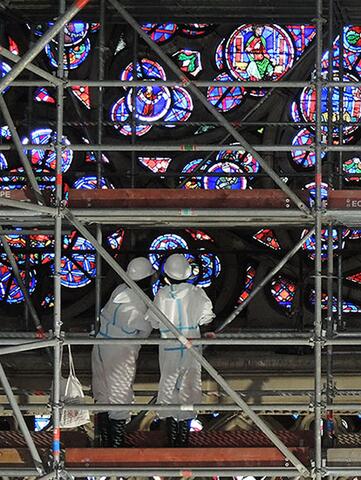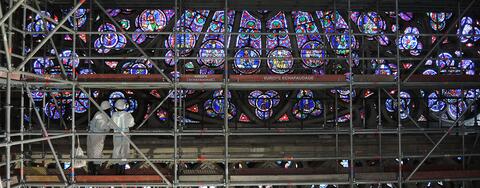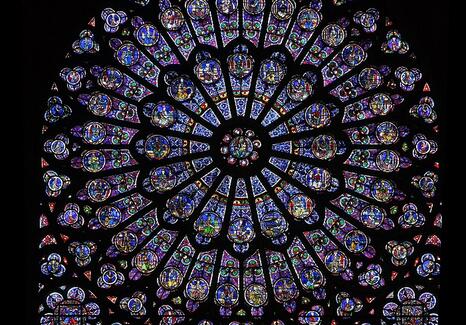

The stained glass windows of Notre-Dame regain their light
While Notre-Dame de Paris is being rebuilt, scientists and restorers are working hand in hand to better understand and preserve its stained glass decoration
Research engineer Karine Boulanger and heritage curator Élisabeth Pillet are part of the Glass working group of the scientific project set up by the CNRS and the Ministry of Culture. Within the Centre André Chastel1, they put their expertise in stained glass at the service of the conservation of this exceptional heritage.
In what condition were the stained glass windows after the fire of April 2019?
Karine Boulanger: Luckily, they suffered very little. Only one, located in the nave, was damaged by one of the tips of the spire that collapsed. But none were destroyed. Nevertheless, dusty and covered with smoke, they had to be thoroughly cleaned like all the cathedral's interiors.
How old are the these windows?
Elisabeth Pillet: Dating from the 13th century, the three medieval roses located on the west, north and south facades are the oldest and most important elements of the cathedral's glass heritage. The other windows date from the 19th century and were installed at the request of the architect Viollet-le-Duc, since most of the stained glass windows had been removed from the building in the 18th century. The work lasted more than ten years and was carried out by the best glass painting workshops of their time.
In the second half of the twentieth century, the stained glass windows in grisaille (non-figurative) in the nave, installed in the previous century, were in turn replaced by abstract stained glass windows.
What do they represent?
K. B.: As the patron saint of the cathedral, the Virgin is honored in the roses. The western rose shows the Virgin with cosmic and earthly time, a zodiac, the works of the months, the struggle of vices and virtues and prophets around her. In the northern arm of the transept, the rose shows the Virgin surrounded by figures from the Old Testament, prophets, kings and judges. The one on the south side has undergone important modifications: in the center, we can see a Christ of the Last Judgment, surrounded by saints, apostles or martyrs, wise virgins and foolish virgins with a crown of angels on the periphery.
E.P.: The 19th century stained glass windows are dedicated to the Virgin Mary, Christ and figures of saints recalling the history of the capital. We also find stained glass windows with only decorative motifs treated in grisaille with sometimes scenes or emblems in the tympanum. All these stained glass windows were created from the idea of the medieval style at that time: some figures have very marked features, and above all a dark patina has been added which contrasts with the stained glass windows of the thirteenth century, which are much brighter.
What were the different stages of their restoration?
K. B.: I intervened in the hours following the fire to prepare the work of the glass painters in charge of removing the stained glass. We quickly realized that there was no removal plan because, except for the three roses, the stained glass windows had never been taken down. The first step was therefore to draw up a plan to locate the windows and the stained glass. For two days we made drawings, took pictures, located and numbered the panels so that the glass painters could begin to remove the high windows. The panels were then stored before being decontaminated and then assigned, last year, to eight restoration workshops in France and one in Germany. The restoration consisted of cleaning the glass as little as possible and consolidating the damaged parts according to the condition of each panel. Today, they are almost ready to be put back together.
You are a member of the glass working group of the Notre-Dame scientific work site ("groupe de travail Verre du chantier scientifique de Notre-Dame1"). What does this group do and what has been your role?
E. P.: Since 2019, this group has been headed by Caludine Loisel, a research engineer at the Laboratoire de Recherche des Monuments Historiques (LRMH), bringing together art historians specializing in stained glass, physicists and chemists. As stained glass specialists, our objective is to study the sources that allow us to document stained glass. We try to find information in the archives on the processes used in the 19th century, as well as the archaeological models that guided the restoration work, the quality of the materials, for example. We are also trying to find out more about the glass painters' workshops that worked on Notre-Dame.
This work is complex because of the lack of documentation on these stained glass windows. It serves both as a memory of the state of their conservation and as an element of expertise for decision-making before interventions. In particular, it will help the restoration workshops to better understand and resolve certain problems of alteration visible on some panels.
K. B.: We examined the 13th century roses in situ, taking advantage of the scaffolding to analyze the authenticity of the stained glass. This allowed us to better understand how the restorations have transformed them over the centuries. This work will continue in the workshop, after the reopening of the cathedral, during future restoration campaigns that will allow more complete analyses when the roses are removed.
What scientific advances are due to this restoration project?
E. P.:The glass group has helped to forge links between very different fields, such as art history, physics and chemistry, for the benefit of the general public and science. In particular, we collaborate with materials scientists from the Faculty of Science. Joint analyses took place when the stained glass windows were passed in front of the Grand Louvre accelerator for elementary analyses (AGLAÉ ) located at the Louvre Museum. Other analyses are in progress. Projects are being financed, such as one devoted to the study of the layer of dust and lead that contaminated these stained glass windows. All these physico-chemical analyses will considerably improve our knowledge of the building and its glass decoration.
K. B. : If the fire was a terrible catastrophe, the restoration project gave the opportunity, seized by the whole scientific world, to better understand the cathedral. A building whose stained glass windows had, contrary to what one might think, been relatively little studied until now.
1. sites in French only
Le martyre de Saint Laurent, entre couleur et lumière




